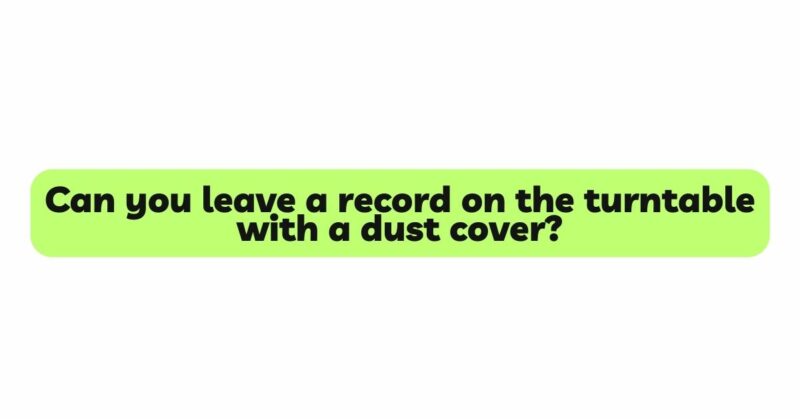Vinyl records, cherished for their warm and authentic sound, have experienced a significant resurgence in recent years. Audiophiles and music enthusiasts alike appreciate the tangible and immersive experience that vinyl offers. As turntables make a comeback, questions arise about the best practices for handling vinyl records and their compatibility with dust covers. One common query is whether it is safe to leave a record on the turntable with the dust cover down. In this article, we will explore the impact of leaving a record on the turntable with a dust cover and provide guidelines for vinyl preservation to ensure the best listening experience and longevity of the cherished vinyl collection.
- Understanding the Purpose of a Dust Cover
A dust cover is a protective shield designed to safeguard the turntable and its components from dust, dirt, and potential damage. It also serves to protect the vinyl record from the same contaminants. When the turntable is not in use, the dust cover is typically closed to ensure the turntable’s internal components and the record remain free from dust accumulation.
- Leaving a Record on the Turntable with the Dust Cover Down
Leaving a record on the turntable with the dust cover down can be a convenient practice, especially if the turntable is frequently used. By keeping the record in place, users can quickly pick up where they left off, simplifying the listening process and saving time.
However, some concerns arise when leaving a record on the turntable for extended periods:
a. Dust Accumulation: Over time, dust and contaminants may accumulate on the record’s surface, particularly if the dust cover is not perfectly sealed or if the environment is prone to dust exposure. Dust particles can potentially cause surface noise, affect playback quality, and even result in slight damage to the record grooves.
b. Static Electricity: In certain environments, static electricity can build up on the turntable and the record, attracting dust particles and causing them to cling to the surface. This static buildup may occur more frequently when the dust cover is closed, potentially leading to a higher risk of dust accumulation on the record.
c. Record Warping: If the turntable or the dust cover is exposed to direct sunlight or heat, there is a risk of the vinyl record warping due to temperature fluctuations. This risk increases if the dust cover is down for extended periods while the turntable is not in use.
- Best Practices for Vinyl Preservation
To ensure the longevity of vinyl records and optimize their sound quality, it is essential to follow some best practices:
a. Store Records Upright: When not in use, it is advisable to store vinyl records upright in their sleeves, preferably in a protective outer sleeve as well. This storage method minimizes the risk of dust settling on the record surface.
b. Use Inner Sleeves: Replace worn or damaged inner sleeves with new ones made of anti-static material. These sleeves help reduce static buildup and protect the record from scratches.
c. Clean Records Regularly: Regularly clean vinyl records to remove dust and contaminants that may have settled on the surface. Proper cleaning will ensure optimal playback quality and prolong the life of the record and stylus.
d. Remove the Dust Cover When Not in Use: If the turntable is not in use for an extended period, consider leaving the dust cover open or removing it entirely. This practice allows air circulation and reduces the risk of dust accumulation on both the turntable and the vinyl record.
e. Avoid Direct Sunlight and Heat: Store vinyl records and turntables away from direct sunlight and heat sources to prevent record warping and damage to the turntable components.
f. Use a Dedicated Listening Space: Consider setting up a dedicated listening space for your turntable, where you can control environmental factors and minimize dust exposure.
- Considerations for Frequent Users
For those who use their turntable regularly and prefer the convenience of leaving a record on the turntable with the dust cover down, certain measures can be taken to mitigate potential issues:
a. Clean the Record Before Playback: Before playing a record, make a habit of gently cleaning the surface with a carbon fiber brush or a record cleaning solution to remove any dust or debris that may have accumulated.
b. Monitor Dust Cover Sealing: Ensure that the dust cover is properly sealed when not in use. Check for any gaps or misalignments that may allow dust to enter the enclosed space.
c. Regular Maintenance: Perform regular maintenance of the turntable, including cleaning the platter and tonearm, to keep it in optimal condition and minimize dust buildup.
- Conclusion
Leaving a record on the turntable with the dust cover down can be a convenient practice for frequent users. However, it is essential to be mindful of potential issues such as dust accumulation, static electricity, and record warping. To preserve the vinyl record’s sound quality and longevity, adopting best practices for vinyl preservation, including regular cleaning, proper storage, and careful maintenance, is crucial.
For those who seek to strike a balance between convenience and vinyl preservation, consider removing the dust cover or leaving it open when the turntable is not in use for extended periods. Additionally, creating a dedicated listening space with controlled environmental factors can help mitigate the risks associated with leaving a record on the turntable with the dust cover down.
Ultimately, prioritizing vinyl preservation and adhering to best practices will ensure an optimal listening experience and prolong the life of the cherished vinyl collection.


